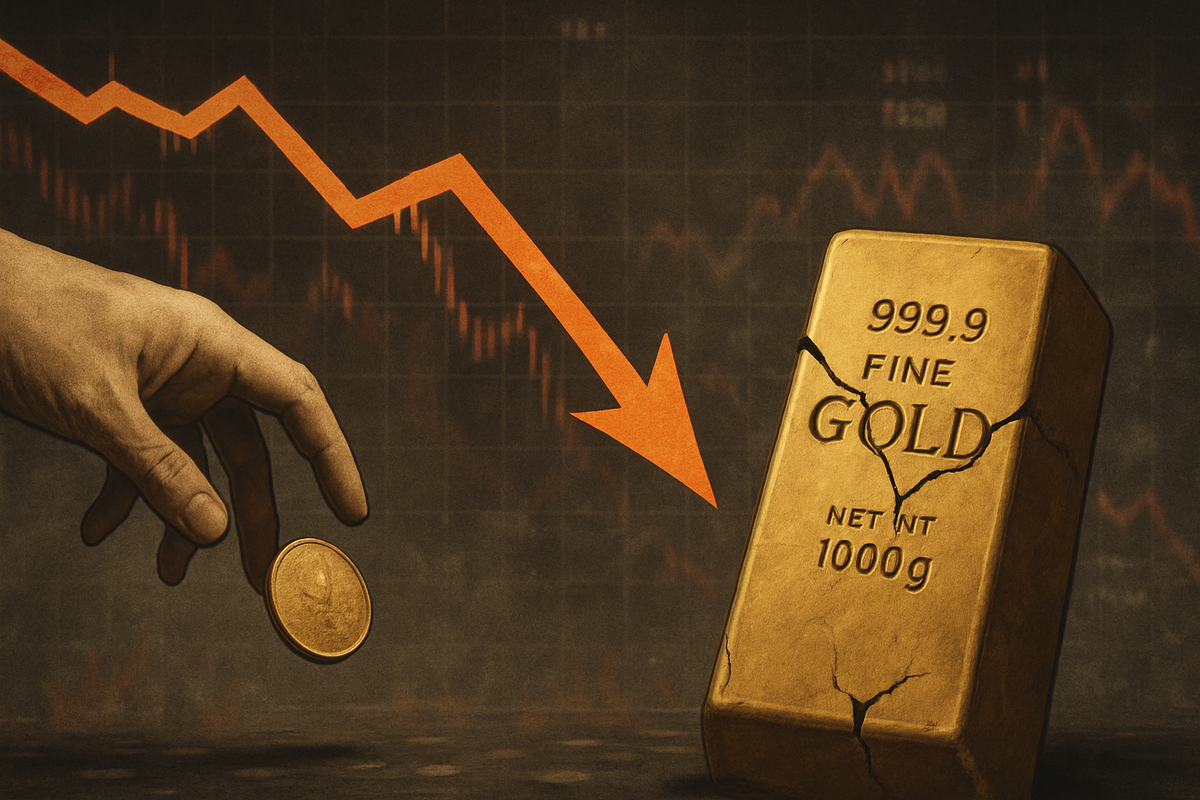
The global financial markets were rattled this week as gold, the traditional safe-haven asset, experienced its most significant correction in 12 years. On October 21, 2025, prices plummeted by as much as 6.3% intraday, falling to near $4,000 an ounce, extending losses into October 22. This dramatic downturn follows an extraordinary rally earlier in the year that saw the precious metal surge by an impressive 55-60%, reaching an all-time high of nearly $4,400 per ounce. The sudden reversal has prompted investors and analysts alike to scrutinize the factors behind this seismic shift and ponder what lies ahead for the glittering commodity.
Unpacking Gold's Historic Plunge
Gold's dramatic correction on October 21, 2025, marked a pivotal moment in the commodity markets, witnessing the largest intraday percentage drop in over a decade. After months of relentless ascent, which saw prices climb from roughly $2,750 at the start of the year to nearly $4,400 per ounce, the precious metal encountered a perfect storm of selling pressure. This sharp decline was not an isolated event; silver and platinum also experienced significant drops, indicating a broader shift in investor sentiment away from precious metals.
The timeline leading up to this moment reveals a period of euphoric bullishness, fueled by persistent geopolitical tensions, inflationary concerns, and robust central bank buying. However, signs of an "overbought" market had been flashing for weeks, with many technical analysts anticipating a healthy correction. The catalyst for the downturn appeared to be a combination of factors: aggressive profit-taking by investors eager to lock in gains from the year's impressive rally, a strengthening U.S. dollar making gold more expensive for international buyers, and perhaps most significantly, a sudden easing of market risk aversion.
Initial market reactions were swift and pronounced. Gold mining stocks, particularly those with higher operating costs, saw their valuations dip sharply as investors anticipated compressed profit margins. Major players in the gold market, including large institutional funds and individual investors who had ridden the wave up, were caught off guard by the speed and magnitude of the sell-off. The shift in risk sentiment was reportedly driven by renewed hopes of a U.S.-China trade deal, with a planned meeting between President Donald Trump and Chinese President Xi Jinping boosting overall market confidence and diverting capital towards riskier assets.
Corporate Ripples: Winners and Losers in the Gold Market
The abrupt gold correction sends ripples across the corporate landscape, creating both significant headwinds and potential opportunities for various public companies. Gold mining companies, naturally, are at the forefront of those affected. Large-cap miners like Newmont Corporation (NYSE: NEM) and Barrick Gold Corporation (NYSE: GOLD), while generally more resilient due to diversified operations and lower production costs, will likely see their share prices react negatively in the short term. The immediate impact will be on their revenue projections and profit margins, especially if gold prices consolidate at lower levels. Smaller, higher-cost producers, which often operate on thinner margins, face a more precarious situation, with the potential for significant earnings revisions and increased financial pressure.
Conversely, companies that benefit from a stronger U.S. dollar or a general uptick in risk appetite might see a positive shift. Financial institutions with significant exposure to equity markets or those involved in facilitating international trade could experience improved sentiment. Furthermore, industries that utilize gold as a raw material, such as electronics manufacturers or luxury goods companies, might benefit from potentially lower input costs, though the impact is often marginal compared to other operational expenses.
Beyond direct mining operations, the correction also impacts companies in the precious metals streaming and royalty business, such as Franco-Nevada Corporation (NYSE: FNV) and Wheaton Precious Metals Corp. (NYSE: WPM). While these companies are less exposed to direct operational costs and often have fixed-price agreements, a sustained downturn in gold prices would still affect the value of their future streams and royalties, potentially dampening investor enthusiasm for their stock. The broader commodity trading houses and funds that hold significant gold positions will also need to re-evaluate their portfolios and risk management strategies in light of this volatility.
Broader Implications and Historical Context
This recent gold crash fits into a broader narrative of market volatility and shifting investor sentiment that has characterized the mid-2020s. The initial surge in gold prices was a clear reflection of heightened global uncertainty, persistent inflationary pressures, and a flight to safety. The correction, therefore, signals a potential, albeit perhaps temporary, recalibration of these underlying concerns. It suggests that while fundamental drivers for gold remain strong, the market is also highly sensitive to shifts in geopolitical discourse and macroeconomic indicators, particularly the strength of the U.S. dollar and expectations for interest rates.
The ripple effects of this event extend beyond the precious metals sector. A perceived easing of global tensions, particularly between the U.S. and China, could inject renewed optimism into global trade and manufacturing, potentially benefiting export-oriented economies and companies. Conversely, if the optimism proves fleeting, the market could quickly revert to a risk-off environment, pushing gold back into favor. Regulatory bodies will be closely monitoring market stability and investor protection, especially given the rapid price movements.
Historically, sharp corrections in gold are not uncommon, even within a long-term bull market. For instance, significant pullbacks occurred during the 2008 financial crisis and in 2013, following a prolonged rally. In both cases, these corrections were eventually followed by renewed upward trajectories, albeit after periods of consolidation. The current event shares similarities with these precedents, suggesting that while painful in the short term, it might be a necessary "reset" for a market that had become technically overextended. The key difference this time is the magnitude of the preceding rally and the specific cocktail of geopolitical and monetary policy factors at play.
What Comes Next for the Golden Asset
Looking ahead, the gold market is poised for a period of heightened scrutiny and potential volatility. In the short term, analysts widely anticipate continued price consolidation around the $4,000-$4,100 per ounce level. While the immediate shock of the 6.3% intraday drop has subsided, the market will be testing whether the $4,000 mark can hold as a significant psychological and technical support level. A decisive break below this could trigger further declines, potentially towards the $3,800 or even $3,600 range, as some of the weaker hands are shaken out.
Long-term possibilities, however, remain overwhelmingly bullish according to many market experts. The underlying drivers that fueled gold's initial ascent – persistent geopolitical risks, ongoing inflationary pressures, and continued central bank diversification away from the U.S. dollar – have not fundamentally dissipated. Furthermore, expectations of potential Federal Reserve rate cuts in the future continue to make non-yielding assets like gold more attractive. Strategic pivots for investors might involve using this correction as an opportunity to accumulate gold at a discount, assuming a long-term horizon.
Market opportunities could emerge for contrarian investors or those looking to rebalance their portfolios with a hedge against future uncertainties. Challenges include navigating continued price swings and accurately assessing the longevity of the current risk-on sentiment. Potential scenarios range from a rapid rebound if geopolitical tensions flare up again or economic data disappoints, to a more prolonged period of sideways trading as the market digests the recent gains and losses. Some forecasts, like those from JPMorgan Research, project gold averaging around $3,675 by Q4 2025, gradually increasing towards $4,000 by mid-2026, with others seeing it surpass $5,000 by mid-2026 or the end of the decade.
Comprehensive Wrap-Up: A Healthy Correction or a Turning Point?
The recent gold crash, culminating in a 6.3% intraday drop on October 21, 2025, represents the most significant correction in 12 years, following an unprecedented rally. The key takeaways from this event are multi-faceted: it highlights the market's sensitivity to profit-taking, U.S. dollar strength, and shifts in geopolitical sentiment, particularly regarding U.S.-China relations. While painful for those caught off guard, many analysts view this as a "healthy" technical adjustment rather than a fundamental reversal of gold's long-term trend.
Moving forward, the gold market is likely to remain dynamic. Short-term volatility and consolidation are expected, with the $4,000 per ounce level serving as a crucial battleground for bulls and bears. However, the overarching consensus points to a constructive long-term outlook, underpinned by enduring macroeconomic and geopolitical factors. Central bank buying, inflation hedging, and the allure of a safe haven amidst global uncertainties are expected to continue providing a strong floor and potential for future appreciation.
The lasting impact of this correction will be a renewed appreciation for gold's inherent volatility, even within a strong uptrend. Investors should watch for several key indicators in the coming months: any further developments in U.S.-China trade talks, shifts in global inflation data, statements from major central banks regarding monetary policy, and continued trends in central bank gold purchases. This event underscores that while gold remains a vital component of diversified portfolios, even the most glittering assets are subject to the ebb and flow of market forces.
This content is intended for informational purposes only and is not financial advice








